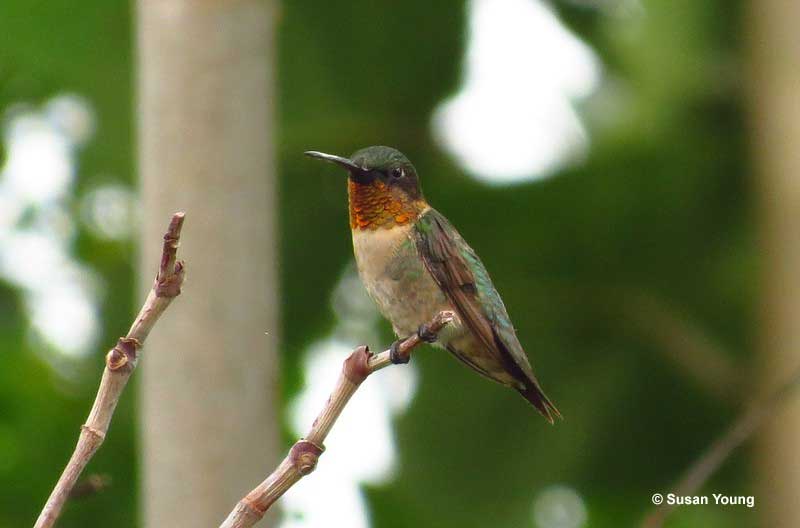Ruby-throated Hummingbirds (Archilochus colubris) are captivating jewels native to eastern North America.
Recognized for the vibrant ruby-red throat patch on males, they thrive in diverse habitats, from woodlands to gardens. If you think you’ve seen one of those agile hummers, read further to learn more about them.
However, if you’re not sure, then here’s some helpful information to get you started on your identification journey.
On this page
Identification
Ruby-throated Hummingbirds are relatively small birds, measuring 2.8-3.5 inches long with a wingspan of 3.1-4.3 inches. Their black bill is slender and slightly downcurved. They have narrow dark wings. If the bird is perching, the tips of the wings don’t go past the tail tip.
Male
Male Ruby-throated Hummingbirds have metallic emerald green upperparts, grayish underparts, a black mask, pale greenish sides, and white chests. Their most distinguishing feature is their iridescent fiery red throat. However, depending on the light and the viewing angle, the throat can appear darker or even black. Males are also smaller than females and have a forked tail.
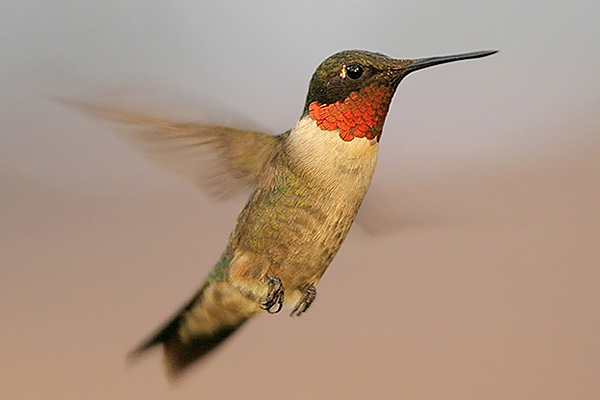
Photograph © Greg Lavaty.
Immature males look more similar to females. They still have green upperparts and grayish underparts, pale greenish sides, and dark wings. However, their throat is white with green streaks and a few iridescent red spots.
Female
Female Ruby-throated Hummingbirds don’t look too different from males. They also have beautiful metallic green upperparts and grayish underparts, but they don’t have much green on their sides and they lack the iridescent red throat gorget. Instead, their throat is whitish with faint green spotting. Females are also slightly larger than males and have a squared tail instead of a forked one.
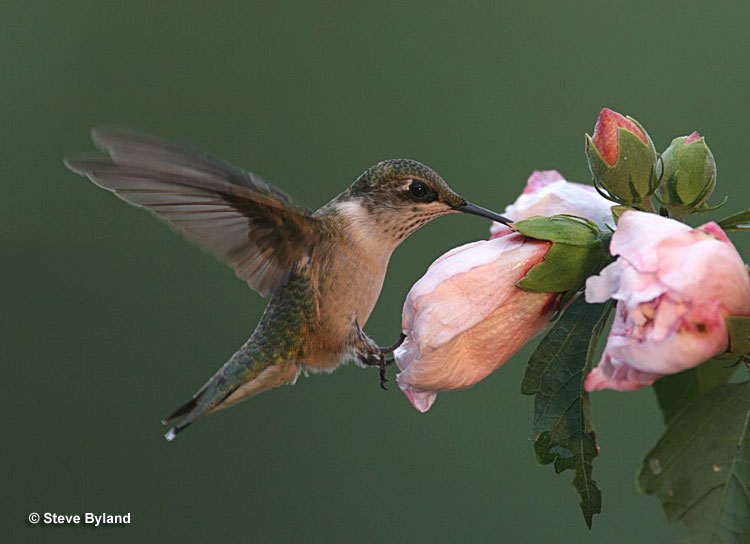
Juvenile Ruby-throated Hummingbirds resemble females. They have green uppersides, whitish undersides, and a pale throat spotted with small green dots.
Vocalizations
If you have spent enough time amongst hummingbirds and learning about them, you might distinguish Ruby-throated Hummingbirds from other species by their sounds and calls. Most of the calls and sounds they produce are meant for threatening and sound like squeaking mice. In the morning, males give a series of monotonous chips. You may hear both sexes give chee-dit calls to communicate.
They also produce sounds with their wings. During courtship flights, males emit a rapid tik-tik sound with their wings. Both sexes fly with a quiet humming sound, but it is quieter and lower-pitched in females and louder and higher-pitched when it comes to males.
Food
Ruby-throated Hummingbirds have a specialized diet consisting of nectar from flowers, supplemented by small insects and spiders for essential proteins and nutrients.
Their primary source of sustenance is nectar. They are particularly attracted to brightly colored red, orange, and pink tubular flowers, such as cardinal flower, honeysuckle, trumpet creeper, bee-balm, red buckeye, red morning glory, jewelweed, columbine, and fire-pink.
The bird uses its long, slender bill and extendable, tube-like tongue to reach deep into the flower and extract it.
While nectar provides the energy needed for their high metabolism, Ruby-throated Hummingbirds also require proteins and nutrients obtained by consuming insects and spiders, such as mosquitoes, fruit flies, gnats, and small bees.
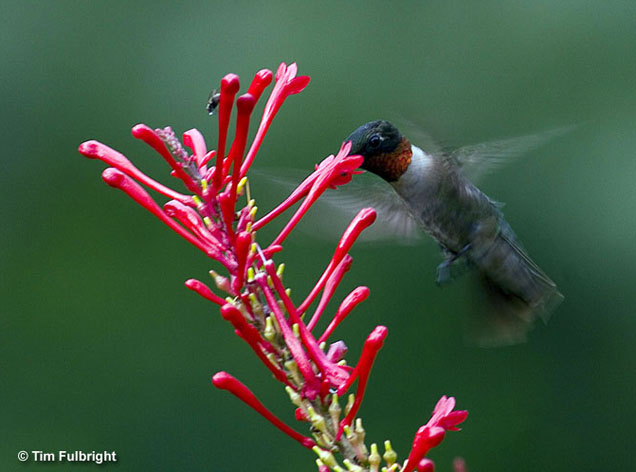
They catch these small arthropods by hawking (snatching them in mid-air) or by gleaning them from leaves and spider webs. This insectivorous component of their diet is especially important during the breeding season and when raising chicks.
On occasion, they may also drink tree sap or visit hummingbird feeders for sugar water.
Nesting and Eggs
Ruby-throated Hummingbirds are not monogamous and do not form breeding pairs. Males establish their territory on the breeding grounds and start performing courtship displays to appeal to females who have entered their territory. They rise up and then perform a looping, U-shaped dive from above the female.
If the female is interested, she’ll perch and the male will start rapidly flying side-to-side in front of her. This is generally followed by mating if the female accepts the advance.
Males will mate with as many females as they please and leave the female to nest and take care of the young on her own.
Ruby-throated Hummingbird nests are commonly situated near the tip of a downcurved branch that is concealed by the canopy above but is fairly open below. Females generally build the small two-inch cups in deciduous trees 10-40 feet above the ground.
They build it from small, pliable, and soft plant material, such as fine grasses and plant fibers, weave it together with spider silk so the nest remains flexible as the clutch grows, and line it with plant down, such as thistle or dandelion. To camouflage it, the outside of the nest is covered with dead leaves, moss, or lichens.
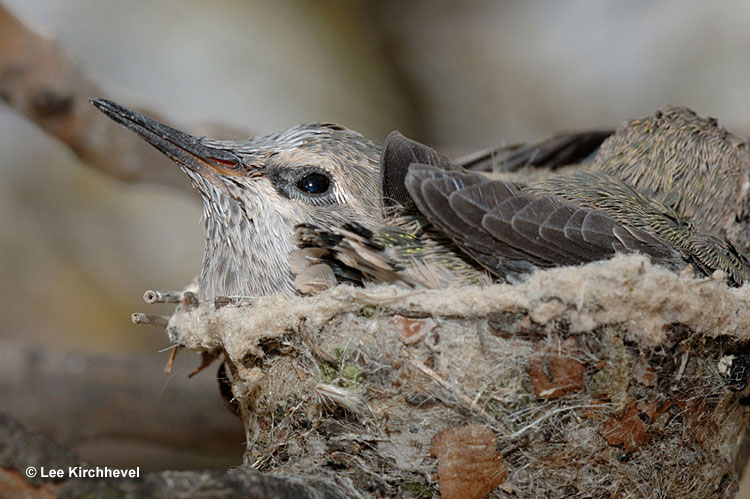
Females may have up to two, rarely three broods in a year with 1-3, usually 2 white eggs in a clutch. Ruby-throated Hummingbird eggs are tiny, measuring 0.5-0.6 inches long and 0.3 inches wide. It takes the female 10-14 days to incubate them. After the eggs hatch, the female will feed her offspring 1-3 times an hour by regurgitating a mix of insects and nectar into their throats. The young leave the nest after 18-22 days at which point they become independent.
Current Situation
Ruby-throated Hummingbirds range through North and Central America. In North America, they are found in southern Canada and the eastern United States during the breeding season. After the breeding season ends, they migrate to Mexico for the winter but can also be found at the tip of Florida.
Ruby-throated Hummingbirds inhabit a variety of semi-open environments, including open deciduous and pine forests, open woodlands, forest edges, gardens, meadows, and coastal areas. They are often associated with areas that provide a mix of flowering plants, as they rely on nectar as their primary food source.
This species is listed as of least concern on the IUCN Red List and they’re one of the most common hummingbirds in eastern North America. During the 19th century, they were hunted for collection but their numbers never dropped too low. Now, their population is increasing.
Facts
- If you want to attract Ruby-throated Hummingbirds to your garden, plant pink, orange, and especially red flowers as they are attracted to those colors.
- Ruby-throated Hummingbirds have a high heart rate. While resting, their heart beats about 225 beats per minute. This increases to 1,250 beats per minute when they’re flying.
- Ruby-throated Hummingbirds have the least feathers of all bird species, between 900-950!
- The average life span of Ruby-throated Hummingbirds is 3-5 years. The oldest Ruby-throated Hummingbird lived to be 9 years and 2 months old!
Similar Species
Ruby-throated Hummingbirds have several similar species, especially when it comes to females, such as the Black-chinned Hummingbird, Broad-tailed Hummingbird, and Anna’s Hummingbird. However, if you get a good look, then correct identification should not be a problem.
Black-chinned Hummingbird
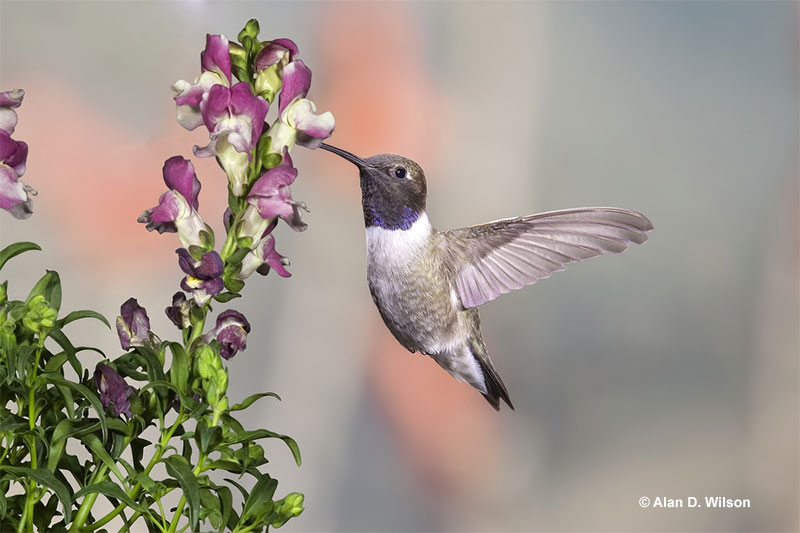
The Black-chinned Hummingbird’s and Ruby-throated Hummingbird’s ranges technically only overlap in the state of Texas in the US.
Male black-chins are dull greenish above and dull grayish below with greenish-grayish sides. They have a black throat with a dark iridescent purple base that isn’t always visible. In poor light, it is easy to mix up the males of these two species, so try to catch a glimpse of either the red throat of Ruby-throated or the purple of the Black-chinned Hummingbird.
For females, take a look at their wings and tails when they’re perched. Female Black-chinned Hummingbirds have wings that reach or slightly exceed the tip of their tail whereas the wings of Ruby-throated Hummingbirds won’t make it near their tail.
Broad-tailed Hummingbird
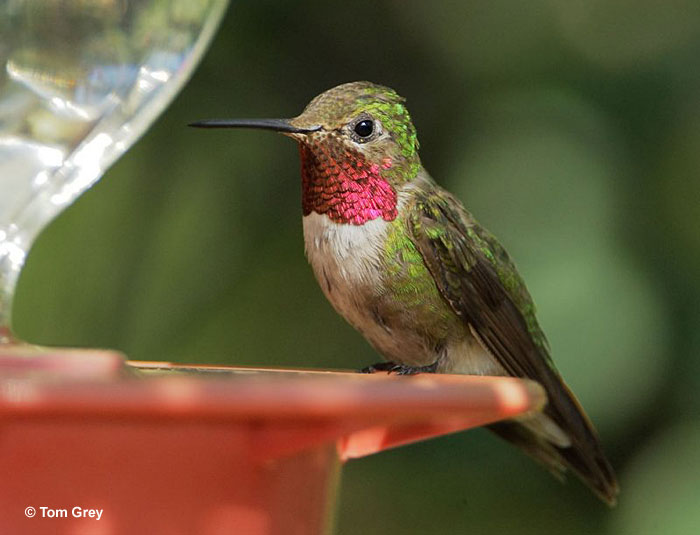
Broad-tailed Hummingbirds inhabit the western United States, so their ranges do not overlap. Males are green above, have green flanks, otherwise whitish undersides, and an iridescent rosy-red throat.
They look quite similar but male Ruby-throated Hummingbirds have an orange-red throat and a black mask instead of a pinkish-red throat and a green cap like the male Broad-tailed Hummingbirds do.
Females would be difficult to differentiate with the only indicator being their tail feathers. The female Ruby-throated Hummingbird has green and black tail feathers whereas the Broad-tailed Hummingbirds have cinnamon as well.
Anna’s Hummingbird
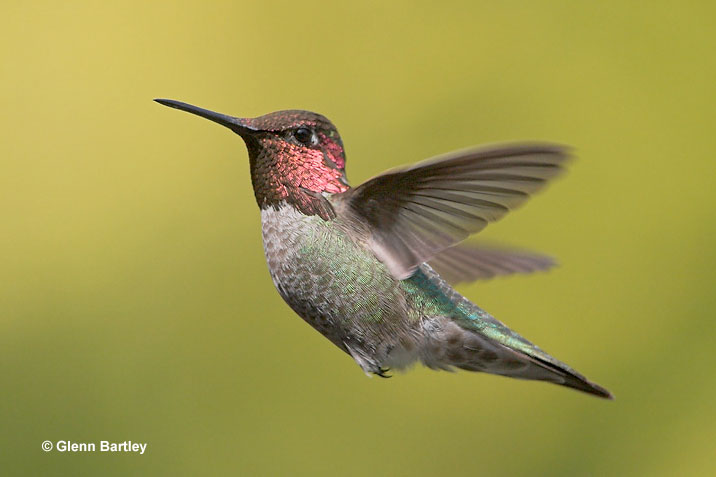
Anna’s Hummingbirds range throughout the western United States and do not have overlapping areas with Ruby-throated Hummingbirds.
Overall, the plumage of both sexes looks very similar. For males, the difference lies in their head and throat coloring. Ruby-throated Hummingbirds have a dark cap and mask and an orange-red gorget whereas Anna’s Hummingbirds have a greenish head and iridescent rosy-red forehead and gorget. Females are nearly identical, but female Anna’s Hummingbirds have greener flanks.
Frequently Asked Questions
What is so special about Ruby-throated Hummingbirds?
Ruby-throated Hummingbirds have one of the lowest feather counts in birds.
What’s the lifespan of Ruby-throated Hummingbirds?
The average lifespan of Ruby-throated Hummingbirds is 3-5 years.
What are Ruby-throated Hummingbirds’ nicknames?
Some nicknames for Ruby-throated Hummingbirds include rubies, hummers, and ruby throats.
When do Ruby-throated Hummingbirds migrate?
Ruby-throated Hummingbirds start their migration in late February to early March and start flying back to their wintering grounds in late August or September.
Where do Ruby-throated Hummingbirds winter?
Ruby-throated Hummingbirds winter in Central America and the southern tip of Florida.

